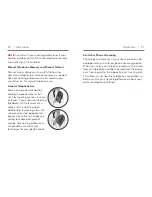
Regulatory Information | 47
46 | Regulatory Information
If you have reservations about your ability to adapt to amplification, you should
inquire about the availability of a trial-rental or purchase-option program� Many
hearing aid dispensers now offer programs that permit you to wear a hearing aid
for a period of time for a nominal fee after which you may decide if you want to
purchase the hearing aid�
Federal law restricts the sale of hearing aids to those individuals who have
obtained a medical evaluation from a licensed physician� Federal law permits a
fully informed adult to sign a waiver statement declining the medical evaluation
for religious or personal beliefs that preclude consultation with a physician� The
exercise of such a waiver is not in your best health interest and its use is strongly
discouraged�
A hearing aid will not restore normal hearing and will not prevent or improve a
hearing impairment resulting from organic conditions� Use of a hearing aid is
only part of hearing habilitation and may need to be supplemented by auditory
training and instruction in lip reading� In most cases infrequent use of a hearing
aid does not permit a user to attain full benefit from it�
Some hearing aid users have reported a buzzing sound in their hearing aid
when they are using mobile phones, indicating that the mobile phone and
hearing aid may not be compatible� According to the ANSI C63�19 standard
(ANSI C63�19-2007 American National Standard Methods of Measurement
of Compatibility Between Wireless Communications Devices and Hearing
Aids), the compatibility of a particular hearing aid and mobile phone can be
predicted by adding the rating for the hearing aid immunity to the rating for
the mobile phone emissions� For example, the sum of a hearing aid rating
of 2 (M2/T2) and a telephone rating of 3 (M3/T3) would result in a combined
rating that equals at least 5 would provide “normal use”; a combined rating
of 6 or greater would indicate “excellent performance�” See your Quick Start
Guide included with your hearing aids for their exact M/T ratings�
CHILDREN WITH HEARING LOSS:
In addition to seeing a physician for a medical evaluation, a child with a hearing
loss should be directed to an audiologist for evaluation and rehabilitation since
hearing loss may cause problems in language development and the educational
and social growth of a child� An audiologist is qualified by training and experience
to assist in the evaluation and rehabilitation of a child with a hearing loss�
Required Multiflex Tinnitus Information for
Hearing Professionals
INDICATIONS FOR USE
The Multiflex Tinnitus Technology is a tool to generate sounds to be used in a
Tinnitus Management Program to relieve patients suffering from tinnitus� The
target population is primarily the adult population over 18 years of age�
The Multiflex Tinnitus Technology is targeted for healthcare professionals, which
are treating patients suffering from tinnitus, as well as conventional hearing
disorders� The fitting of the Multiflex Tinnitus Technology must be done by a
hearing professional participating in a Tinnitus Management Program�
INSTRUMENT DESCRIPTION
Multiflex Tinnitus Technology is a software function that generates sound which
is programmed into a hearing aid� The hearing aid may be used in one of three
modes of operation: as a hearing aid, as a tinnitus treatment instrument or as a
hearing aid and tinnitus treatment instrument�
When enabled, the Multiflex Tinnitus Technology generates the sound and allows
a patient’s hearing professional to design and program appropriate settings for
an individually prescribed sound treatment plan� The treatment plan should be
used in a tinnitus management program for relief of tinnitus�
Multiflex Tinnitus Technology generates a broadband white noise signal that
varies in frequency and amplitude� These characteristics are adjustable by the
hearing professional and are specific to the prescribed therapy designed by
the professional for the patient’s needs and comfort�
The patient may have some control of the level or volume of the signal and
the patient should discuss this adjustment as well as his or her comfort level
and sound of the signal with their hearing professional�
WARNING TO HEARING CARE PRACTITIONER
A hearing care practitioner should advise a prospective sound generator user to
consult promptly with a licensed physician (preferably an ear specialist) before
using a sound generator if the hearing care practitioner determines through
inquiry, actual observation or review or any other available information concerning
the prospective user that the prospective user has any of the following conditions:
i� Visible congenital or traumatic deformity of the ear�
ii� History of active drainage from the ear within the previous 90 days�
iii� History of sudden or rapidly progressive hearing loss within the previous
90 days�
iv� Acute or chronic dizziness�
v� Unilateral hearing loss of sudden or recent onset within the previous 90 days�
CAUTION:
If set to the maximum output level and worn for periods of
time exceeding the recommendations below, the patient’s exposure to sound
energy has the potential to exceed noise exposure limits� This hearing aid is
intended for use for a maximum of sixteen (16) hours a day when set at the
maximum output level�
































